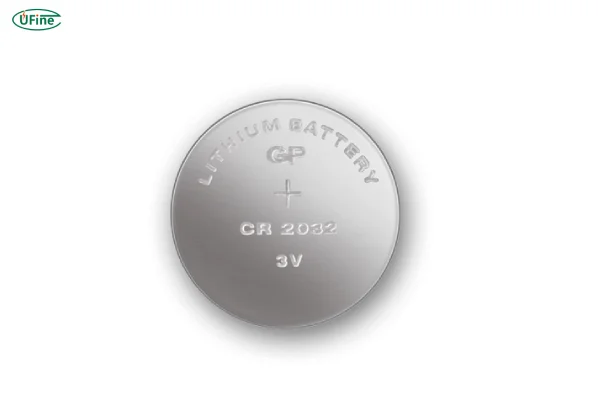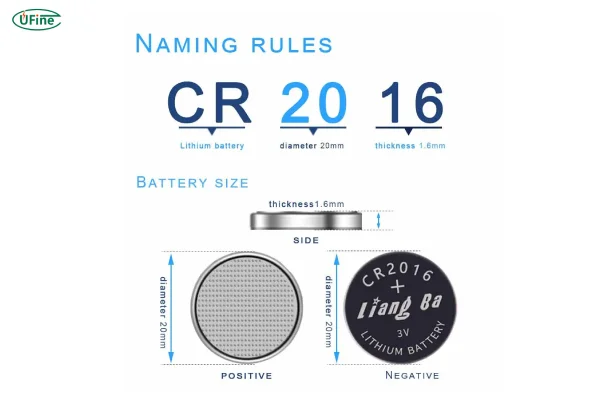
Part 1. What is a CR battery?

A CR battery is a coin-cell battery primarily used in small electronic devices like watches, key fobs, calculators, and medical devices. The “CR” in its name stands for lithium chemistry — “C” for lithium and “R” for round shape. These batteries are incredibly compact, and their design allows them to fit in tight spaces while delivering reliable and long-lasting power.
What sets CR batteries apart is their use of lithium-based chemistry. This type of chemistry allows them to deliver a high voltage (typically 3.0 volts) and a longer shelf life compared to older battery types. CR batteries are non-rechargeable and come in a variety of sizes, each with its specific applications.
The lithium manganese dioxide (LiMnO2) chemistry, which most CR batteries use, offers several advantages over other types. It’s stable, long-lasting, and capable of handling a wide range of temperatures. This is why CR batteries are found in everything from hearing aids and fitness trackers to remote controls and key fobs.
CR Battery Naming Convention
Understanding the naming convention of CR batteries is essential when selecting the right battery for your device. The most common format for naming CR batteries follows this pattern: CR####. Here, the “C” and “R” represent the lithium chemistry and the round shape, but the numbers that follow provide crucial details about the battery’s size and capacity. Let’s break it down:
- First two digits (e.g., 20 in CR2025): These numbers represent the diameter of the battery, measured in millimeters (mm).
- Last two digits (e.g., 25 in CR2025): These indicate the thickness (or height) of the battery, also in millimeters.
For example, the CR2025 battery has:
- A diameter of 20 mm.
- A thickness of 2.5 mm.
Other common CR battery sizes follow the same pattern:
- CR1632: Diameter of 16 mm, thickness of 3.2 mm.
- CR2032: Diameter of 20 mm, thickness of 3.2 mm.
- CR2032 is one of the most commonly used batteries for devices such as remote controls, motherboards, and fitness trackers.
Part 2. How does CR battery size affect battery performance?
The size of a CR battery significantly influences its performance. Larger batteries tend to offer higher capacity and longer battery life, while smaller batteries are more compact and can power devices that require less energy. The size of the battery, in essence, determines how long your device will operate before needing a replacement.
For example, a CR2032 battery is often used in devices that require a bit more power, such as remote controls or motherboards. It has a larger surface area, which allows for more energy storage and can provide a longer lifespan. On the other hand, a CR1632 battery, while providing less energy, is ideal for smaller devices like calculators and key fobs, where space is at a premium.
It’s important to note that capacity (measured in milliampere-hours or mAh) is directly related to the size of the battery. A larger CR battery can provide more current over a longer period, making it perfect for devices that need extended runtime. But, a larger battery might not always fit in smaller devices, which is where smaller options like the CR1220 or CR1216 come into play.
Part 3. CR battery size chart
A quick reference to the size options available can help you determine which CR battery is the right fit for your device. Here’s a simple chart to guide you:
| Battery Size | Diameter | Height | Capacity (mAh) | Common Applications |
|---|---|---|---|---|
| CR1025 | 10.0 mm | 2.5 mm | 35-45 mAh | Key fobs, small devices |
| CR1216 | 12.0 mm | 1.6 mm | 30-50 mAh | Watches, medical devices |
| CR1632 | 16.0 mm | 3.2 mm | 130-160 mAh | Calculators, toys |
| CR2032 | 20.0 mm | 3.2 mm | 200-220 mAh | Computer motherboards, hearing aids |
| CR2450 | 24.5 mm | 5.0 mm | 500 mAh | Fitness trackers, remote controls |
| CR2025 | 20.0 mm | 2.5 mm | 150-170 mAh | Car remotes, LED lights |
As you can see, each battery size has its own specifications, including diameter, height, and capacity, which directly impact how it performs in your device. Choosing the right size based on these factors ensures you get the optimal performance from your battery.
CR2032 vs CR2025 Battery: Which One IS Batter?
Part 4. CR battery voltage
CR batteries typically have a voltage of 3.0 volts, a key factor in their widespread use. This voltage is consistent across most sizes, making it easy to use different sizes interchangeably, as long as they’re compatible with the device’s design.
The voltage determines the amount of energy that the battery can deliver to the device. 3.0 volts is relatively high for such a compact form, which is why CR batteries are so effective at providing consistent power for extended periods.
In most cases, the voltage won’t change much from one size of CR battery to another. What changes, however, is the capacity, which affects how long the battery lasts before it needs to be replaced. So while the voltage of a CR2032 and a CR1632 might both be 3.0V, the larger CR2032 will last much longer due to its higher mAh rating.
Part 5. CR battery type
The type of CR battery you use is primarily determined by its chemical composition, which affects how it performs under different conditions. The most common type of CR battery uses lithium manganese dioxide (LiMnO2), which is stable, lightweight, and capable of providing reliable performance over time.
In addition to LiMnO2, CR batteries can also use other lithium-based chemistries, such as lithium iron disulfide (LiFeS2). While LiFeS2 batteries are less common, they offer improved safety features and are often used in high-power devices like cameras and digital gadgets.
Different chemistries influence a battery’s voltage stability, shelf life, and performance in extreme temperatures. For instance, lithium-based chemistries excel in both cold and high-temperature environments, which is one of the reasons why CR batteries are so widely used in outdoor gear, GPS units, and medical devices.
Part 6. Is CR battery rechargeable?
The short answer is no, CR batteries are not rechargeable. These batteries are designed to be single-use, meaning once they are depleted, they must be replaced. Unlike rechargeable lithium-ion (Li-ion) or nickel-metal hydride (NiMH) batteries, CR batteries are made with a non-rechargeable chemistry that does not support recharging.
Attempting to recharge a CR battery can result in damage to the battery or the device it’s powering. Additionally, there is a risk of overheating or even leakage, which can be hazardous. If you need a rechargeable battery for your device, consider alternatives like Li-ion or NiMH batteries.
Part 7. What size CR battery should I use?
The key to choosing the right CR battery size is to consider your device’s specific needs. Start by consulting the device’s manual or the old battery to ensure you pick the correct one. Using the wrong size can lead to poor performance, malfunction, or even damage to your device.
Here are a few general guidelines:
- Watches, calculators, and small devices: Use CR1216, CR1632, or CR2025.
- Larger electronics like remotes and fitness trackers: CR2032 or CR2450 is often the best fit.
- Specialized devices like medical equipment or cameras: CR2032, CR2025, or CR2450 are common options.
If you are unsure about the size, it’s always better to go with the manufacturer’s recommendations. A quick search online will also tell you which CR battery size fits your device.
Part 8. FAQs
-
Can I use a CR2032 instead of a CR2025?
Yes, as long as the battery compartment can accommodate the thicker CR2032. -
How long do CR batteries last?
The shelf life of CR batteries can be anywhere from 5 to 10 years, depending on usage. -
Are CR batteries environmentally friendly?
Yes, but they should still be recycled properly to minimize environmental impact. -
What happens if I use the wrong CR battery size?
It could cause performance issues, and the battery may not fit properly or might not power your device at all. -
What size CR battery is best for a remote control?
CR2032 or CR2450 is typically used in remote controls.
Related Tags:
More Articles

Do Lithium Batteries Require Special Strap Downs? (Safety + Vibration Control)
Discover why lithium batteries require special strap downs to prevent vibration damage, terminal stress, and internal component issues.
Battery Strap Down Safety Tips: Preventing Vibration Damage and Terminal Stress
Follow these expert battery strap down safety tips to prevent vibration damage, terminal stress, and ensure LiFePO4 battery longevity.
How to Choose a Good 18650 Battery with Reliable Quality?
Battery quality defines performance and safety. Ufine Battery shares how to source good 18650 batteries and avoid unstable suppliers.
Can I Use a Universal Battery Strap Down on LiFePO4 Batteries? (Compatibility Guide)
Learn whether universal battery strap downs are compatible with LiFePO4 batteries, and how to install them safely for vibration control.
Battery Strap Down vs Battery Hold-Down Bracket: What’s the Difference?
Compare battery strap downs and hold-down brackets. Learn key differences, installation tips, and which is safer for lithium batteries.



